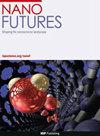MoS2 nanocomposites for biomolecular sensing, disease monitoring, and therapeutic applications
IF 3.3
4区 材料科学
Q3 MATERIALS SCIENCE, MULTIDISCIPLINARY
引用次数: 0
Abstract
The unique physicochemical properties of MoS2 nanocomposites have drawn escalation in attention for the diagnosis and therapy of cancer. Mostly the 2D forms of MoS2 find application in sensing, catalysis, and theranostics, where it was traditionally applied in lubrication and battery industries as electrodes or intercalating agents. As nanostructures, MoS2 has a very high surface-to-volume ratio, and that helps in the engineering of structures and surfaces to promote absorption of a wide range of therapeutics and biomolecules through covalent or non-covalent interaction. This surface engineering provides excellent colloidal stability to MoS2 and makes them ideal nanomedicines with higher selectivity, sensitivity, and biomarker sensing ability. Furthermore, MoS2 exhibits exceptionally well optical absorption of NIR radiation and photothermal conversion, which helps in the NIR-responsive release of payloads in photothermal and photodynamic therapy. There are several reports that the fabricated MoS2 nanomedicines can selectively counter the tumor microenvironment, which leads to the accumulation of therapeutics or imaging agents in the diseased tissues to improve the therapeutic effects decreasing the adverse effects on the healthy cells. An overview of the basic structure and properties of MoS2 is presented in this article, along with an elaborative description of its morphology. At the same time, an attempt was made in this review to summarize the latest developments in the MoS2 structure, surface engineering, and nanocomposite formulations for improving biocompatibility, bioavailability, biomolecular sensing, and theranostic applications.MoS2纳米复合材料用于生物分子传感、疾病监测和治疗应用
二硫化钼纳米复合材料以其独特的物理化学性质在癌症的诊断和治疗中引起了越来越多的关注。2D形式的二硫化钼主要应用于传感、催化和治疗领域,传统上用于润滑和电池行业,作为电极或插层剂。作为纳米结构,二硫化钼具有非常高的表面体积比,这有助于通过共价或非共价相互作用促进多种治疗药物和生物分子的吸收。这种表面工程为二硫化钼提供了良好的胶体稳定性,使其具有更高的选择性、灵敏度和生物标志物感知能力。此外,MoS2对近红外辐射的吸收和光热转换表现出非常好的光学特性,这有助于在光热和光动力治疗中释放NIR响应的有效载荷。有报道称,制备的二硫化钼纳米药物可以选择性地对抗肿瘤微环境,从而导致治疗药物或显像剂在病变组织中积累,从而提高治疗效果,减少对健康细胞的不良影响。本文概述了二硫化钼的基本结构和性质,并对其形貌进行了详细的描述。同时,本文综述了二硫化钼结构、表面工程和纳米复合材料在提高生物相容性、生物利用度、生物分子传感和治疗应用方面的最新进展。
本文章由计算机程序翻译,如有差异,请以英文原文为准。
求助全文
约1分钟内获得全文
求助全文
来源期刊

Nano Futures
Chemistry-General Chemistry
CiteScore
4.30
自引率
0.00%
发文量
35
期刊介绍:
Nano Futures mission is to reflect the diverse and multidisciplinary field of nanoscience and nanotechnology that now brings together researchers from across physics, chemistry, biomedicine, materials science, engineering and industry.
 求助内容:
求助内容: 应助结果提醒方式:
应助结果提醒方式:


